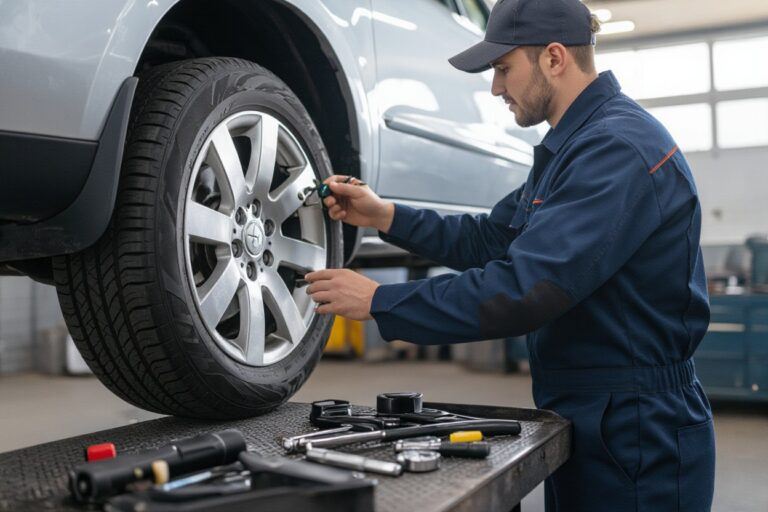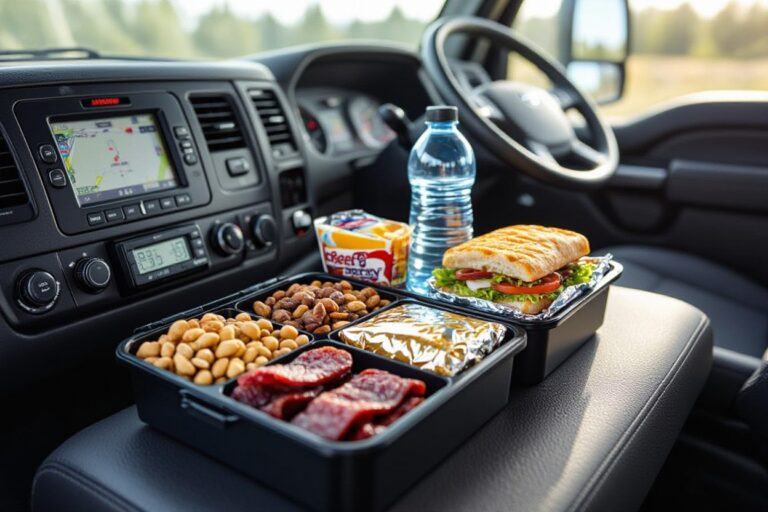
Most truck drivers, including you, can increase your per-mile pay by combining smarter lane selection, skill upgrades and professional habits. Focus on negotiating higher rates and tracking all paid miles, pursue specialized endorsements (HAZMAT, tanker, doubles) that command premium pay, and run fuel- and time-efficient routes. Keep discipline on hours and maintenance because safety violations or preventable accidents can cost you thousands and destroy pay opportunities. Consistency and clear records make you more valuable to brokers and fleets.
The Real Factors Driving Pay Per-Mile Rates
- pay-per-mile
- market demand
- freight classifications
- deadhead
- seasonality
Load pay hinges on concrete variables: lane length, backhaul availability, fuel surcharge, accessorials, and load type—refrigerated and hazmat often carry premiums while high deadhead kills your effective rate; short runs under 250 miles commonly show $0.60–$1.20/mi while specialized lanes can push that higher. Brokers pay differently than direct shippers, and detention or permits can shave 10–20% of take-home. Assume that by cutting deadhead and targeting specialty lanes you can boost your effective pay-per-mile by 15–30%.
Analyzing Market Demand vs. Supply
Freight availability swings with season and commodity—produce season in the Southeast can lift reefer demand by 15–40%, while retail holidays spike dry-van lanes. You should monitor DAT and Cass indices, watch van/reefer/flatbed spot spreads, and map where driver density creates supply gluts that depress spot pay; pairing outbound lanes with consistent backhauls or using load boards for short, high-paying hops reduces your exposure to oversupplied markets.
Understanding Freight Classifications and Pricing
NMFC classes (roughly 50–500) tie to density, liability, and handling: denser freight and stable pallets lean toward lower classes and cheaper LTL rates, while bulky, fragile items push class up; for example, a 800 lb shipment occupying 32 cu ft equals ~25 lb/ft³, which typically lands in a lower class than a bulky 800 lb load at 120 cu ft. You should factor class into pricing decisions and packaging choices.
Digging deeper, you can actively change class outcomes: consolidate smaller shipments to reach full-truck status, palletize and reduce void space to increase density, or repackage to lower dimensional impact—each move can drop class and cut LTL cost by 10–40%. Dispute reclassifications with strong documentation (photos, measurements, NMFC codes) and negotiate base rates or minimums with carriers; for many owner-operators, moving from LTL to small TL lanes or bundling regular customers yields the biggest per-mile gains.

The Power of Negotiation: Securing Higher Rates
Push beyond spot-rate thinking and negotiate the whole contract: rate per-mile, fuel-surcharge formula, accessorials, detention, layover, and payment terms. Use market tools like DAT or Truckstop to show comparable lanes and present your operational metrics — on-time >98%, claims <0.5%, deadhead 10% — to justify a premium. Small concessions on lane exclusivity or guaranteed weekly miles can often translate into a $0.10–$0.50/mi uplift versus one-off loads.
Strategies for Effectively Negotiating Contracts
Lead negotiations with data and specific asks: propose a fuel surcharge tied to the OPIS diesel index, request detention at $50/hr after 2 hours, set accessorial rates (e.g., $75 for extra stops) and aim for Net-15 payment or faster ACH. Offer performance guarantees—dedicated lanes of 2,000 miles/week at a fixed rate, or annual escalators of 3% or CPI-linked increases—and benchmark your ask against current market averages to make the case.
Building Relationships with Freight Brokers
Respond within 24–48 hours, provide ELD/TMS integration and electronic PODs, and keep insurance and safety scores current to become a preferred carrier; brokers reward reliability with recurring lanes that can cover up to 70% of your weekly miles, reducing deadhead and boosting effective per-mile pay.
Give brokers clear performance metrics: average transit times, detention occurrences, and a claims rate below 0.5%. Offer lane-specific pilots—three-month trials with minimums—to prove value, then lock in higher rates once you demonstrate consistency. Case example: one driver moved from spot loads at $1.60/mi to broker-negotiated dedicated lanes at $2.05/mi, a 27% increase by leveraging guaranteed miles, faster invoicing, and documented on-time performance.
Leveraging Skills and Certifications for Increased Earnings
You can boost per-mile pay by stacking specific endorsements and skills that carriers value; many drivers report a 3–15% pay increase after adding HazMat, tanker, or TWIC access, and some specialized lanes pay an extra $0.02–$0.10 per mile. Focus on credentials that open higher-paying contracts—chemical, port, oversized and refrigerated freight often have built-in premiums and sign-on bonuses that can add $1,000–$5,000 to annual income.
Essential Endorsements and Specializations
Hazardous materials (HazMat), tanker, doubles/triples and port/TWIC access are the most marketable endorsements; HazMat often unlocks chemical hauls with premiums, tanker allows fuel and liquid chemical loads, and TWIC gets you port work that may add steady higher-rate miles. You should weigh the detailed background checks and extra training required against the clear pay and lane access benefits.
How Advanced Training Can Lead to Higher Pay
Advanced courses—cargo-tank certification, in-depth load securement, and diesel technician upskilling—qualify you for specialty runs and shop roles that pay more: cargo-tank and HazMat combos often yield the highest per-mile increases, while ASE-level diesel tech skills let you command hourly shop rates or transition to higher-paying owner-operator roles.
-
Common Endorsements and Typical Pay Impact
HazMat Opens chemical/flammable loads; typical premium +$0.02–$0.10/mile or 3–10% higher pay Tanker Fuel and liquid hauls; often +$0.01–$0.05/mile and specialized contracts Doubles/Triples Longer freight capacity; some lanes pay +$0.01–$0.04/mile TWIC / Port Access Port runs and container yards; steady work with annual premiums of $150–$1,000
Many carriers run targeted pay programs for certified drivers: fleets commonly offer endorsement bonuses of a few hundred to a few thousand dollars and higher per-mile tiers for certified routes. You can track postings where a HazMat+tanker combo is listed as required and compare the advertised rate—often several cents per mile above standard lanes—to estimate the real earnings lift before investing in training.
-
Advanced Trainings and Expected Returns
Cargo-Tank / Tanker Course Qualifies you for hazardous liquids; typical pay uplift 5–15% on eligible loads ASE / Diesel Tech Certification Enables shop or owner-operator roles; tech pay often $20–$35/hr or higher than entry driver rates Advanced Driver/Defensive Courses Fewer incidents, eligibility for safety bonuses and lower insurance costs—can mean $500–$2,500 in annual bonuses Load Securement / Oversize Transport Training Access to high-value freight with per-mile premiums and higher daily guarantees
The Importance of Route Optimization and Efficiency
Optimize routes to cut empty miles by 10–20%, stack loads in the same geographic corridor, and schedule backhauls to convert deadhead into paid miles. You can route around known choke points (I‑95 and I‑75 bottlenecks at rush hour) to keep average loaded speed higher, and that directly increases the miles you log per hour. For example, reducing 500 empty miles a month at $0.50/mile nets an extra $250—simple routing choices translate into measurable pay-per-mile gains.
Tools and Apps for Maximizing Mileage and Fuel Efficiency
Use truck-specific routing like PC*MILER or CoPilot Truck to avoid low bridges and weight-restricted roads, and pair them with Trucker Path for parking and weigh station intel. Telematics platforms (Samsara, KeepTruckin) give you idling, speed, and fuel-use reports so you can trim MPG‑killing habits; simple coaching from those reports can yield a 1–3% fuel improvement, while aerodynamics and tire fixes can add another 3–6%.
Planning Your Schedule to Minimize Downtime
Block pickups and deliveries to create contiguous driving windows and sidestep long waits: aim for a morning pickup, a midday drop inside a 200–300 mile radius, and a backhaul that starts before the evening rush. Schedule fuel stops at stations with cheaper diesel (use Fuelbook or GasBuddy) and avoid peak-hour city entries; cutting average detention under 2 hours per stop can turn non‑paying hours into productive miles and raise your effective pay-per-mile.
Digging deeper, map a weekly rhythm that limits idle gaps: target three loads per week that cluster within the same corridor, reserve a 30–60 minute buffer for unexpected delays, and use HOS strategically so you don’t lose whole driving windows to reset time. If you cut downtime by just 10 hours a week and average 45 loaded mph, that’s ~450 extra miles—at $0.50/mile that’s an extra $225/week. Combine that with preferential fueling and planned parking (use Trucker Path or proprietary carrier parking data) and you protect both safety and revenue while reliably increasing your pay-per-mile.
Exploring the Benefits of Owner-Operator Opportunities
Moving into owner-operator work can give you direct control over rates, lanes, and schedules, often translating into higher pay per-mile than company drivers. Many owner-operators use specialized freight or direct broker contracts to push gross rates above $1.75–$2.50 per mile. Expect to handle invoicing, fuel cards, and route planning yourself; with smart load selection and 2,000–2,800 miles per week, you can significantly boost take-home pay compared with salaried driving.
Potential Earnings as an Owner-Operator
Typical gross earnings vary widely, but running 2,500 miles/week at a $2.00/mile average yields about $260,000 gross annually. After common operating costs—fuel, maintenance, insurance, permits, and taxes, often totaling 40–60% of gross—net income commonly lands between roughly $100,000 and $156,000, depending on equipment age, fuel economy, and how well you negotiate loads and reduce deadhead miles.
Weighing the Pros and Cons of Ownership vs. Employment
You gain pricing leverage, tax deductions, and asset value as an owner, but you also absorb downtime, repair bills, and administrative burden that can erode per-mile pay. Leasing onto a reputable carrier can offload back-office work while keeping higher per-mile splits, whereas going fully independent requires capital for a truck, insurance, and contingency reserves—typically tens of thousands up front.
Pros vs. Cons of Owner-Operator Ownership
| Pros | Cons |
|---|---|
| Higher per-mile rates and ability to pick profitable loads | Upfront truck purchase or lease costs and down payments |
| Tax deductions for equipment, fuel, and business expenses | Variable cash flow and risk during slow seasons |
| Greater scheduling flexibility and choice of lanes | Responsibility for maintenance and unexpected repairs |
| Opportunity to build equity in equipment | Higher insurance and compliance costs |
| Potential for broker direct contracts and specialized loads | Time spent on admin: invoicing, permits, and accounting |
| Ability to subcontract or expand to multiple trucks | Need for business skills and sometimes hiring help |
| Control over fuel and routing efficiency | Exposure to market rate fluctuations |
Assess your tolerance for financial risk and administrative work before committing: if you have solid cash reserves (six months of operating costs), mechanical knowledge, and sales skills to secure regular loads, ownership can pay off handsomely. If you prefer predictable pay and less paperwork, consider lease-on options or dedicated company runs that still offer higher per-mile splits without full business ownership.
To wrap up
Summing up, you can boost pay-per-mile by targeting high-paying lanes and specialized freight, minimizing deadhead miles, optimizing fuel and maintenance, improving CSA scores and on-time delivery, investing in certifications or endorsements, leveraging freight apps and brokers, and negotiating rates or pursuing owner-operator status. Track expenses and use technology to prove performance so you can justify higher offers and steadily grow your earnings.
FAQ
Q: What certifications or endorsements can help a truck driver earn higher pay per mile?
A: Specialized endorsements expand the types of freight you can haul and usually command higher per-mile rates. Common high-value endorsements include HazMat (H), Tanker (N), Doubles/Triples (T), and sometimes a TWIC card for port work. To get them you’ll need the required training, written and/or skills tests, and background checks for HazMat. After you earn them, target carriers and brokers that move specialized freight, ask dispatch for loads that require those endorsements, and list them prominently on load boards and your resume. Many drivers see a measurable pay premium for specialty lanes because shippers pay more for certified, qualified drivers; combine endorsements to maximize marketability.
Q: How can route planning and reducing empty miles (deadhead) increase my effective pay per mile?
A: Per-mile pay improves when more of your miles are revenue miles. Reduce deadhead by planning backhauls, running dedicated lanes, and using load boards or freight brokers to book a return load before leaving a delivery. Use routing and load-matching apps to find nearby loads and optimize pickup/drop sequences to cut empty miles and idle time. Negotiate with dispatch for guaranteed minimums, drop-and-hook or live-load preferences to shorten waits, and factor accessorial pay (detention, layover, loading/unloading) into your accepted jobs so you’re compensated for non-driving time. Track and analyze your routes for patterns of empty mileage and shift lanes or customers to those with more consistent backhaul opportunities.
Q: Should I stay a company driver, become an owner-operator, or lease on to earn more per mile?
A: Each option can raise your gross per-mile rate but affects net income differently. As a company driver you get steady pay and fewer overheads; you can increase per-mile pay by switching to higher-paying carriers, taking specialized loads, or negotiating performance bonuses. Owner-operators and lease-on drivers generally receive higher per-mile rates because they cover fuel, maintenance, insurance, and taxes; to make this profitable you must control operating costs (fuel discounts, preventive maintenance, route efficiency) and understand taxes, IFTA and deductions. Leasing to a reputable carrier can offer higher pay with administrative support, but read the lease terms and fee schedules closely. Another route is team driving or dedicated contracts that pay premium rates for faster transit time. Before changing your employment model, run a realistic budget comparing gross per-mile to estimated expenses so you know the net effect on take-home pay.



